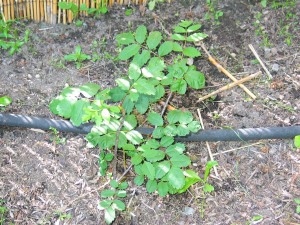Toddlers and Teens
Like animals, plants have a life cycle and like animals some play out all the seasons of their life in just a few of our seasons. Others have a life expectancy similar to that of a human. Some live far longer though it is rare to have a tree like Llangernyw Yew or even the Endicott Pear Tree in a place where you can see it daily.*
Lately I have begun to identify plants by their ages. Some are toddlers. One of the key differences between babies and toddlers, besides the toddling, is that toddlers have mostly lost baby proportions and begun to look like real people.
In a similar way young plants can be babyish. Take the Sitka Mountain Ash I purchased almost three years ago now. It arrived during winter, wrapped in brown paper, two spindly dormant six-inch branches poking out of the center of the dark soil filling a quart container that seemed too large. For two springs leaves formed at the end of each of the stems, leaves that were small and yellow-green. They resembled the pictures in my reference books in shape only. During this time, neither of the branches grew more than a few centimeters.
This spring, when I finally made my way out the back corner, I didn’t recognize it at first. Each of the original branches is closer to a foot long and there are smaller stems growing off each. The leaves are a darker blue-green shade and twice as large as those last summer. I may have to wait another year or more for flowers and berries but now it is perfectly identifiable as an ash.
If the human transition to toddler is marked mostly by appearance and action, the one to the teen years is almost always described as a change in mood. Plants are more pleasant. Plant teens bloom, literally. This year two of the native plants in my garden officially became teens.
The thimbleberry was first. It’s another one of the plants that went in during the year after I took the Habitat workshop. For two summers its maple-like leaves have waved in the breeze. Even a crow swooping through on its way to the rooftop can set the large soft leaves undulating. This May little buds formed in bunches at the end of several branches. Last week, one by one, they opened to delicate white petaled flowers heavy with pollen and holding court for the bees.
Now that the flowers have shed their petals and the pollen has been carried off by insects and the wind, it is time to wait again. Will I get my first taste of thimbleberry this year?
Just as the last blooms were fading on the thimbleberry, the Woods’ rose caught my attention. Planted during the same time frame, the rose has been healthy. Its expanding needle covered stems have grown to provide a formidable barrier between the bird bath and the neighbor’s cat. Until this year it hasn’t lived up to its name. One morning last week, the cloudy gloom was brightened when I discovered tight dark red buds topping off most of the branches. A few had swollen leaving tiny slits exposing the pink wrapped inside waiting to emerge.
Thimbleberries in the summer and rose hips in the winter. So much to look forward to!
* Both of these trees are listed in the wikipedia list of the oldest trees. The Yew lives in a churchyard in Wales. The pear tree is in Danvers, MA where I spent a lot of time in my early adulthood. I never knew that that oldest living fruit tree in the US was so close by.
Explore posts in the same categories: Uncategorized


Leave a comment